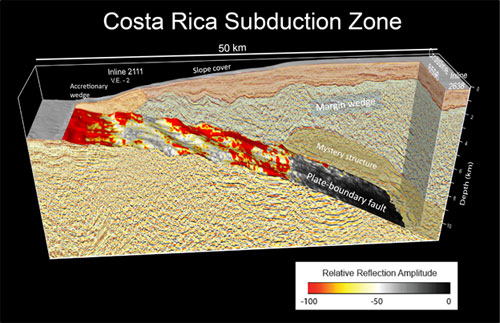A 3D look at the structure, hydrogeology, and the seismogenic zone along the Costa Rica margin
By:
Nathan Bangs
UTIG
| When: | Friday, February 28, 2014, 10:30 a.m. to 11:30 a.m. Join us for coffee beginning at 10:00 a.m. |
| Where: | Seminar Conference Room, 10100 Burnet Road, Bldg 196-ROC, Austin, Texas 78758 |
| Host: | Nick Hayman, UTIG |
Click for a Live Broadcast.

Abstract
In 2011 an international team of scientists acquired a 3D seismic reflection data volume from the Costa Rica margin using the R/V Marcus Langseth. We acquired these data just northwest of the Osa Peninsula along a segment of the margin that has repeatedly had moderate (Mw 6.4 - 6.9) plate-boundary thrust earthquakes, and has been the target of two IODP drilling legs.
One of the main goals of this project was to image the plate-boundary thrust fault system to determine how physical properties along the plate interface change downdip from the trench at the toe of the slope, to the source regions of the earthquakes at depths of ~ 6-8 km beneath the margin shelf. In sediment-rich subduction zones, this downdip transition is thought to be largely controlled by the loss of fluids and declining fluid pressures.
However, the Costa Rica margin is a sediment-poor subduction zone with a substantially different fluid supply and "plumbing system" than sediment-rich subduction zones. The role of fluids in sediment-poor subduction zones is poorly known.
In this talk I will present an overview of the Costa Rica margin tectonics inferred from the 3D deformational structures, infer the plumbing system within this sediment-poor subduction system, and show how the plumbing system influences slip on the subduction thrust.




